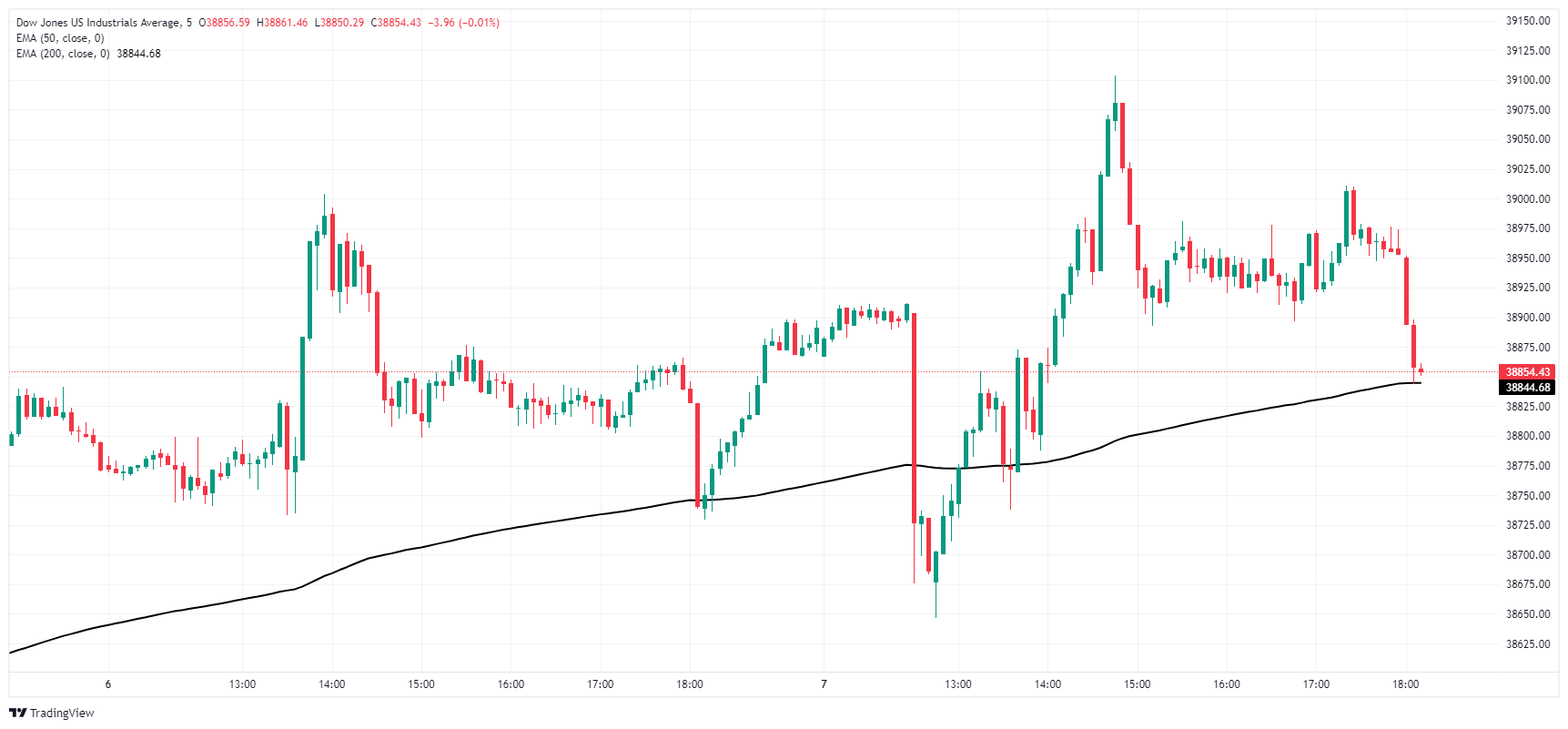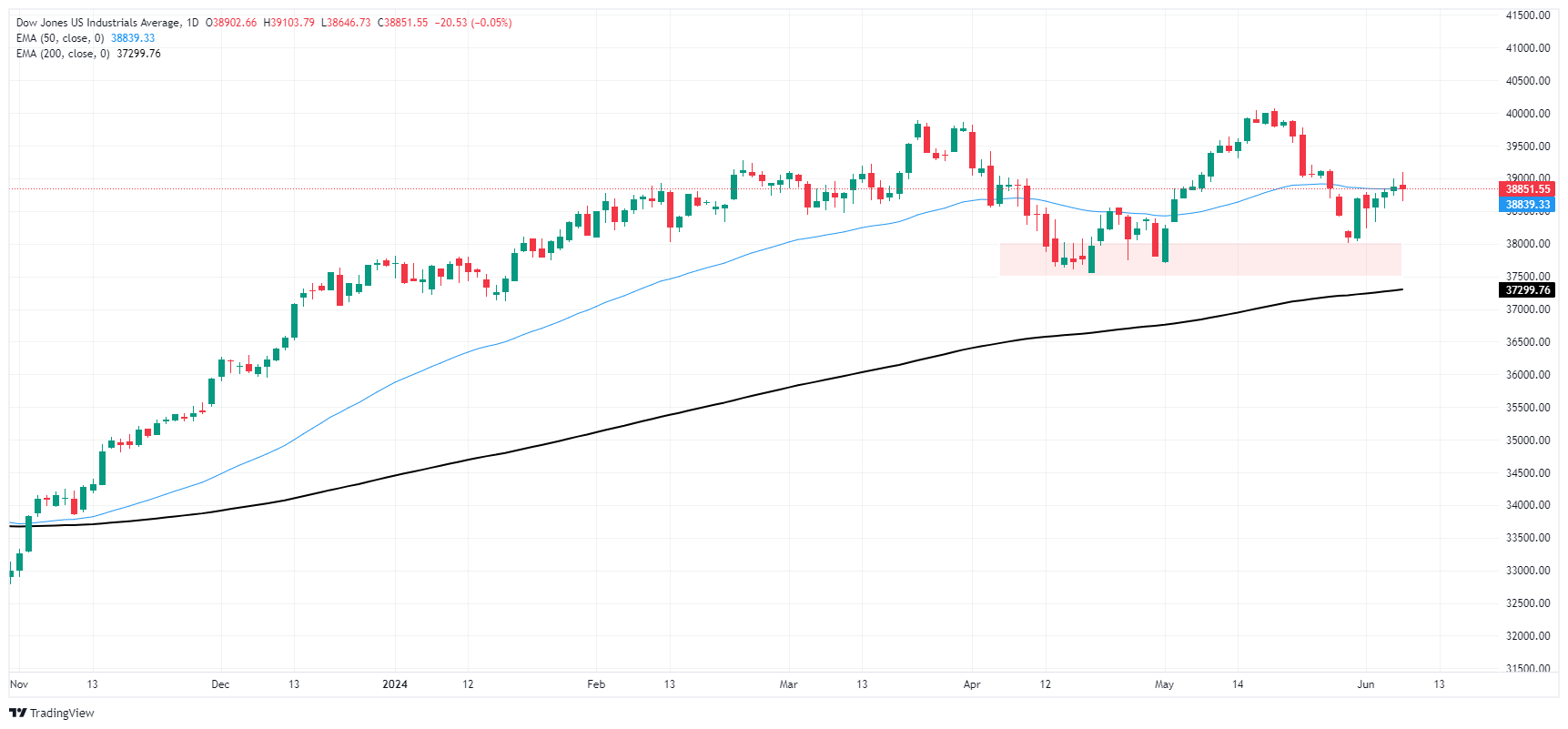- Phân tích
- Tin tức và các công cụ
- Tin tức thị trường
- Dow Jones Industrial Average struggles to shrug off Friday’s firm NFP beat
Dow Jones Industrial Average struggles to shrug off Friday’s firm NFP beat
- Dow Jones grinds into the middle as investors shrug off declining rate cut bets.
- The US added 272K net new jobs in May.
- US wages also climbed faster than expected, crumpling September rate cut hopes.
The Dow Jones Industrial Average (DJIA) shrugged off a forecast-thumping Nonfarm Payrolls (NFP) print on Friday, climbing into a brief 0.2% gain through the US market session before slumping back to the day’s opening bids after a reactionary tumble to better-than-expected jobs additions in May.
US Nonfarm Payrolls delivered its third-best monthly net job gains on Friday, adding 272K new employment positions in May, well above the forecast 185K. The figure handily beat the previous month’s figure, which was revised slightly lower to 165K from 175K.
US Average Hourly Earnings also climbed faster than expected, showing wages increased 0.4% MoM versus the forecast 0.3% and the previous 0.2%. Meanwhile, the US Unemployment Rate also ticked up to its highest level since February 2022, printing at 4.0% versus the expected hold at 3.9%.
With the US economy continuing to outperform investor expectations, broad-market hopes for Federal Reserve (Fed) rate cuts continue to get battered. According to the CME’s FedWatch Tool, rate traders are now pricing in barely 51% odds of a at least a quarter-point rate trim from the Fed on September 8, down significantly from the 70% odds that were priced in until just before Friday’s NFP print.
Dow Jones news
After some initial post-NFP jitters, the DJIA is recovering firmly on Friday. Two-thirds of the major index’s constituent securities are in the green on the day, with gains being led by 3M Co. (MMM), which is up around 3% in Friday’s trading. 3M’s stock was recently upgraded to a “buy” by Bank of America analysts, prompting investors to do just that. 3M crossed over $100 per share on Friday, and is up nearly 12% for the year.
On the low side, Unitedhealth Group Inc. (UNH) fell -1.8% on Friday, falling to $493.00 per share. UNH is down around -6.25% from mid-May’s peak near $525.00 per share, and Friday’s share prices are shedding further weight following the announcement of a shareholder lawsuit against the company for alleged losses stemming from securities fraud committed by the healthcare company between March 2022 and February 2024.
Dow Jones technical outlook
The Dow Jones tested the 39,000.00 handle in an intraday recovery on Friday, but fell back to the day’s opening range near 38,880.00. The index is holding steady after recent recovery bids from a near-term low at the 38,000.00 level, but Friday is shaping up to be another soft day to round out the trading week.
The Dow Jones continues to waffle after falling from record all-time highs above 40,000.00, and still remains down -3% from record peaks in May. A firm demand zone is priced in between 38,000.00 and 37,500.00, and the major equity index is still trading deep into bull country above the 200-day Exponential Moving Average (EMA) at 37,299.82.
Dow Jones five minute chart
Dow Jones daily chart
Dow Jones FAQs
The Dow Jones Industrial Average, one of the oldest stock market indices in the world, is compiled of the 30 most traded stocks in the US. The index is price-weighted rather than weighted by capitalization. It is calculated by summing the prices of the constituent stocks and dividing them by a factor, currently 0.152. The index was founded by Charles Dow, who also founded the Wall Street Journal. In later years it has been criticized for not being broadly representative enough because it only tracks 30 conglomerates, unlike broader indices such as the S&P 500.
Many different factors drive the Dow Jones Industrial Average (DJIA). The aggregate performance of the component companies revealed in quarterly company earnings reports is the main one. US and global macroeconomic data also contributes as it impacts on investor sentiment. The level of interest rates, set by the Federal Reserve (Fed), also influences the DJIA as it affects the cost of credit, on which many corporations are heavily reliant. Therefore, inflation can be a major driver as well as other metrics which impact the Fed decisions.
Dow Theory is a method for identifying the primary trend of the stock market developed by Charles Dow. A key step is to compare the direction of the Dow Jones Industrial Average (DJIA) and the Dow Jones Transportation Average (DJTA) and only follow trends where both are moving in the same direction. Volume is a confirmatory criteria. The theory uses elements of peak and trough analysis. Dow’s theory posits three trend phases: accumulation, when smart money starts buying or selling; public participation, when the wider public joins in; and distribution, when the smart money exits.
There are a number of ways to trade the DJIA. One is to use ETFs which allow investors to trade the DJIA as a single security, rather than having to buy shares in all 30 constituent companies. A leading example is the SPDR Dow Jones Industrial Average ETF (DIA). DJIA futures contracts enable traders to speculate on the future value of the index and Options provide the right, but not the obligation, to buy or sell the index at a predetermined price in the future. Mutual funds enable investors to buy a share of a diversified portfolio of DJIA stocks thus providing exposure to the overall index.
© 2000-2025. Bản quyền Teletrade.
Trang web này được quản lý bởi Teletrade D.J. LLC 2351 LLC 2022 (Euro House, Richmond Hill Road, Kingstown, VC0100, St. Vincent and the Grenadines).
Thông tin trên trang web không phải là cơ sở để đưa ra quyết định đầu tư và chỉ được cung cấp cho mục đích làm quen.
Giao dịch trên thị trường tài chính (đặc biệt là giao dịch sử dụng các công cụ biên) mở ra những cơ hội lớn và tạo điều kiện cho các nhà đầu tư sẵn sàng mạo hiểm để thu lợi nhuận, tuy nhiên nó mang trong mình nguy cơ rủi ro khá cao. Chính vì vậy trước khi tiến hành giao dịch cần phải xem xét mọi mặt vấn đề chấp nhận tiến hành giao dịch cụ thể xét theo quan điểm của nguồn lực tài chính sẵn có và mức độ am hiểu thị trường tài chính.
Sử dụng thông tin: sử dụng toàn bộ hay riêng biệt các dữ liệu trên trang web của công ty TeleTrade như một nguồn cung cấp thông tin nhất định. Việc sử dụng tư liệu từ trang web cần kèm theo liên kết đến trang teletrade.vn. Việc tự động thu thập số liệu cũng như thông tin từ trang web TeleTrade đều không được phép.
Xin vui lòng liên hệ với pr@teletrade.global nếu có câu hỏi.















